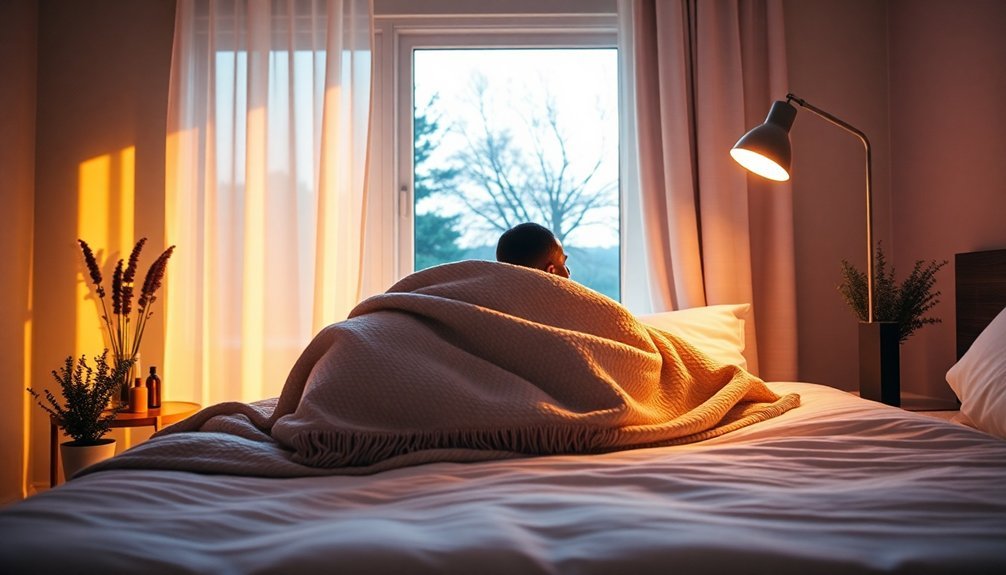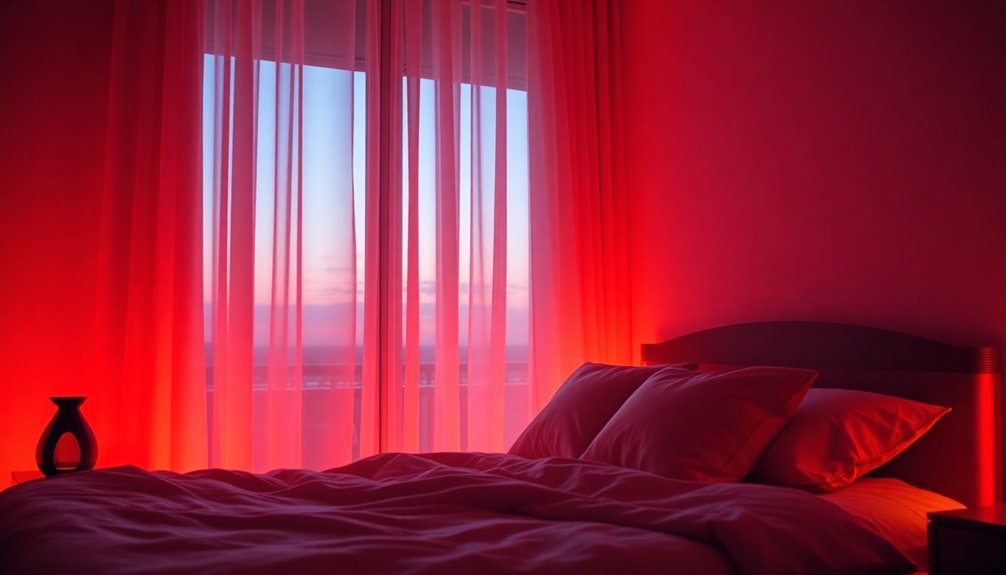Infrared rays can greatly boost your melatonin production in several effective ways. First, optimize your exposure timing; morning sunlight enhances mitochondrial melatonin production while evening infrared therapy promotes regulation before sleep. In addition, enhancing mitochondrial function with near-infrared light boosts cellular health and energy efficiency. Utilizing natural infrared sources like sunlight or fire also promotes melatonin release. Incorporating red light therapy before bed supports melatonin levels without suppression. Finally, combining these techniques with good sleep hygiene practices can improve your overall sleep quality. If you're curious to uncover more tips, keep going to discover additional insights.
Optimize Timing of Infrared Exposure

Optimizing the timing of your infrared exposure can greatly enhance melatonin production and improve your overall well-being. Starting your day with morning infrared light from the sunrise can trigger subcellular melatonin production in mitochondria while mitigating oxidative stress throughout the day. This exposure also supports your natural circadian rhythm and boosts other beneficial chemicals like vitamin D and serotonin.
In the evening, consider using infrared or red light therapy 1-2 hours before bedtime. This practice helps regulate your melatonin levels, ensuring you drift off to sleep more easily. Furthermore, red light therapy not only aids in melatonin production but also is most effective when used before sleep to enhance sleep quality.
Be mindful of blue light from electronic devices during this time, as it can suppress melatonin production. Instead, embrace the natural evening light from a sunset, fireplace, or candle, which is rich in red and infrared wavelengths that promote melatonin release.
Both sunrise and sunset are prime opportunities for infrared exposure, as this is when UV radiation is minimal. If you're outside during these times, make sure your shadow is longer than your body to confirm safe conditions.
Enhance Mitochondrial Function
Infrared exposure not only supports melatonin production but also plays a significant role in enhancing mitochondrial function. When you immerse yourself in near-infrared (NIR) light, it modulates mitochondrial activity by reducing cytochrome c oxidase (COX) activity in a dose-dependent manner. This modulation leads to a slight decrease in enzyme activity without completely shutting it down, improving overall mitochondrial health.
NIR therapy also decreases mitochondrial swelling and boosts mitophagy, the process of removing damaged mitochondria, which can greatly enhance cellular health. Additionally, NIR therapy affects early response genes, leading to increased transcription of gene products that aid in neuronal repair and recovery.
Moreover, exposing your cells to red and infrared light increases ATP production—your body's energy currency. Longer wavelengths recharge your mitochondrial "batteries," facilitating more efficient energy production. This is particularly beneficial for older individuals or those dealing with disease, as studies have shown improved mitochondrial function in aged mice.
Additionally, NIR therapy reduces oxidative stress by decreasing reactive oxygen species during ischemia and protecting mitochondrial function through melatonin production. This ultimately contributes to better neurological outcomes, especially after cardiac events.
Utilize Natural Infrared Sources

The natural world offers abundant sources of infrared light that can greatly enhance your melatonin production and overall well-being. Sunlight, one of the best sources, floods your body with near-infrared energy, boosting melatonin during the day while helping to regulate your circadian rhythm. Aim for at least 30 minutes outdoors in the morning; this resets your internal clock, improves mood, and promotes relaxation. Additionally, exposure to sunlight increases melatonin production, reinforcing its importance for your health.
Don't overlook the warmth of fire and flame sources like campfires or candles. They emit significant amounts of infrared light, which can stimulate melatonin production, especially in the evening. The infrared rays from these fires can penetrate deep into your body, benefiting brain health.
Integrating natural environments into your routine is crucial too. Consider walking outdoors or sitting near windows to enhance your infrared exposure. This helps produce essential health-boosting chemicals like melatonin and serotonin.
Finally, steer clear of artificial light, particularly in the evening. The blue light from screens can suppress melatonin secretion, so winding down without bright lights allows your body to produce melatonin naturally.
Embrace these natural sources of infrared, and watch your well-being flourish.
Incorporate Red Light Therapy
Exploring natural light sources is a fantastic way to enhance melatonin production, but you can take it a step further by incorporating red light therapy into your routine.
Red light therapy supports healthy melatonin levels, especially in the evening when your body naturally prepares for sleep. Unlike blue light, red light doesn't suppress melatonin production, making it ideal for maintaining your sleep-wake cycle.
Here are four key benefits to contemplate:
- Promotes Natural Melatonin Production: Exposure to red light encourages your body to produce melatonin effectively.
- Regulates Circadian Rhythms: It helps synchronize your internal clock, supporting better sleep patterns.
- Aids Those with Sleep Disorders: If you struggle with insomnia, red light therapy can improve your overall sleep quality.
- Reduces Stress and Anxiety: Higher endorphin levels from red light therapy contribute to a calmer, more restful sleep.
Using a high-quality device emitting light in the 660-850 nanometer range at the right time can greatly enhance your sleep experience.
Embrace red light therapy as a non-invasive way to achieve better melatonin production and enjoy a more restorative night's rest.
Combine With Sleep Hygiene Practices

To optimize melatonin production, it's essential to consistently combine red light therapy with solid sleep hygiene practices. Start by maintaining a consistent sleep schedule. Go to bed and wake up at the same time every day, even on weekends. This routine, along with aiming for 7-9 hours of sleep each night, helps regulate your circadian rhythm and melatonin levels.
Next, create a favorable sleep environment. Keep your bedroom dark, cool (ideally between 68-72°F), and quiet. Using comfortable bedding can further enhance your sleep quality, so make sure your bed is inviting and reserved only for sleep.
Incorporate pre-bedtime relaxation techniques to prepare your body and mind for rest. Spend an hour winding down, engage in light stretching, meditation, or deep breathing, and consider taking a warm shower.
Lastly, avoid stimulants and screens before bed. Cut out caffeine and nicotine for at least five hours, limit alcohol, and turn off electronic devices to minimize blue light exposure.
Adjusting these habits alongside red light therapy will greatly improve your melatonin production and overall sleep quality.
Frequently Asked Questions
Can Infrared Light Exposure Increase Melatonin Production During the Day?
Yes, infrared light exposure can increase melatonin production during the day. When you soak in this light, your body activates enzymes in cells that enhance melatonin, supporting energy production and overall cellular health.
How Long Should I Expose Myself to Infrared Light for Benefits?
You should expose yourself to infrared light for about 10-20 minutes daily, especially in the evening. Adjust the duration gradually based on individual tolerance and response to maximize the benefits for your melatonin levels.
Are There Any Side Effects From Excessive Infrared Light Exposure?
Yes, excessive infrared light exposure can lead to eye damage, skin issues, heat-related illnesses, and hormonal disruptions. To minimize risks, wear protective gear, stay hydrated, and limit exposure duration. Prioritize your safety during infrared activities.
Does Skin Type Affect the Effectiveness of Infrared Light Absorption?
Yes, your skin type definitely affects infrared light absorption. Variations in moisture, thickness, and pigmentation change how effectively your skin absorbs these rays. This can influence therapeutic benefits and overall skin responsiveness to infrared treatments.
Can Infrared Light Therapy Be Used Alongside Medication for Sleep Issues?
Yes, you can use infrared light therapy alongside sleep medications. Just make sure to consult your healthcare provider first, ensuring there's no negative interaction, and this therapy may even help reduce your medication needs.
In Summary
By optimizing your timing of infrared exposure and enhancing mitochondrial function, you can greatly boost your melatonin production. Don't underestimate the power of natural infrared sources, and consider incorporating red light therapy into your routine. Ultimately, combining these practices with good sleep hygiene will maximize your results. Embracing these strategies can help you enjoy deeper, more restful sleep and improve your overall well-being. So go ahead, give these methods a try and feel the difference!





Leave a Reply